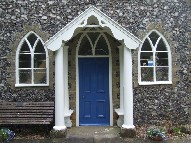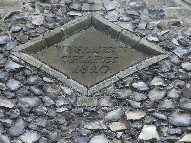| |
|
 |
|
St Andrew is the most
north-easterly of the Saints, and cut off
from most of the others by the Bungay to
Halesworth road, it tends to be fairly
independent of the rest of them. Away
from the main road is this pretty little
Methodist chapel. We're not far from the
Norfolk border, and although Suffolk is
by comparison with its northern neighbour
more generally Baptist country, they seem
to be fairly thin on the ground in the
Saints. In fact, at the time of the 1851
Census of Religious Worship, there were
very few non-conformist congregations at
all around here. The suggestion is, of
course, that the Church of England in
these parts was very low church and
evangelical, with the possible exception
of South Elmham St Margaret. The
incumbency of the Anglican parish church
in St Andrew was unusually still held in
plurality in the 1850s, by a Dr Gilbert,
the head of Bungay Grammar School. He had
been in charge since 1809, when such
arrangements were more common. It was one
of four churches whose livings he
enjoyed, and all the hard work was farmed
out to curates. This may help explain why
less than ten per cent of the parish
population regularly attended the parish
church.
|
This
chapel was one of the beneficiaries. Built in
1840 by the local Wesleyan Society, it had just
18 members, but a regular attendance of well over
a hundred. It is a pretty little building, with
windows in the early Victorian style when Gothic
was prefered but still pre-ecclesiological. The
white portico on classical columns is a
curiosity.
| It is always a pleasure to
come across a building like this in the
East Anglian lanes, especially in such an
outback. The non-conformist chapels are
reminders of a time when religious
differences were taken seriously, and
there was little truck with 'ecumenism'
and the like. More than that, they were
focuses of more than just religious
dissent, and the divisions between church
and chapel often reflected local class
fault lines. Landowners who were
non-conformists would generally expect
their employees to follow suit, but if
they were Anglicans they could easily
prevent the building of chapels in their
parishes. A number of Suffolk chapels are
away from their villages, hidden down
back lanes, sometimes actually inside the
edge of a neighbouring parish. The
lack of non-conformist congregations at
the time this chapel was built should not
lead us to place to much too much
emphasis on the influence of the local
Church of England parish churches. In a
place like the Saints, there was easy
access to the multiplicity of
denominations in the neighbouring town of
Bungay, which in 1851 was able to boast
buildings for Anglicans, Wesleyans,
Primitive Methodists, Congregationalists,
Baptists of two persuasions, and that
tiny grouping which barely appears on the
radar of the 1851 census, but which 150
years later would be the largest
practising denomination in England: the
Catholics.
|
|
 |
|
|
|

